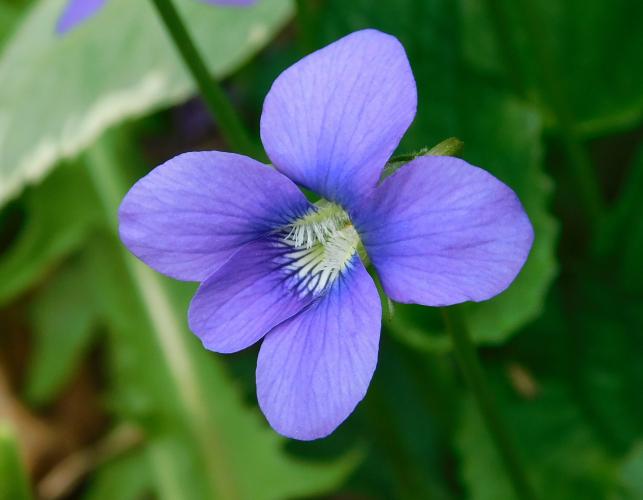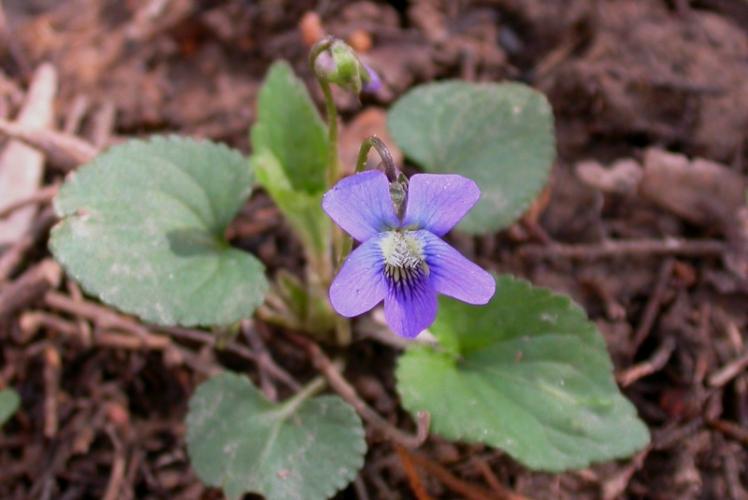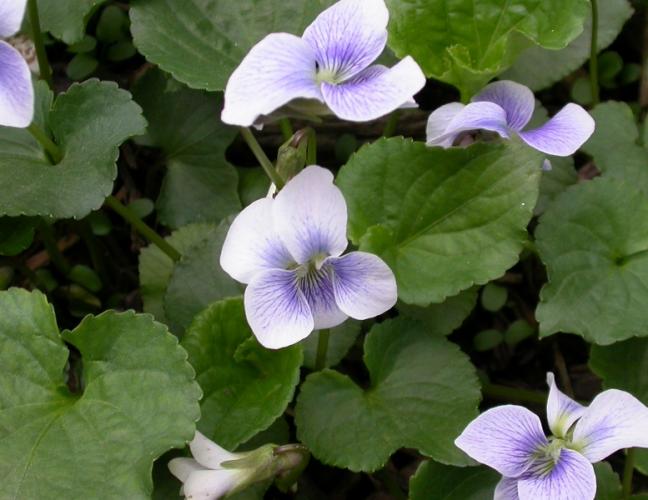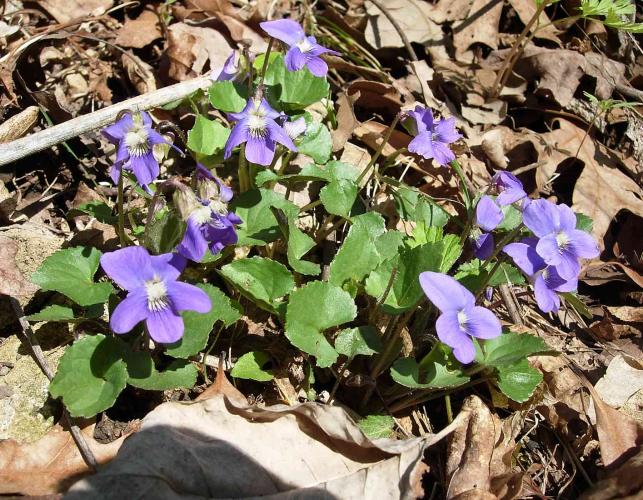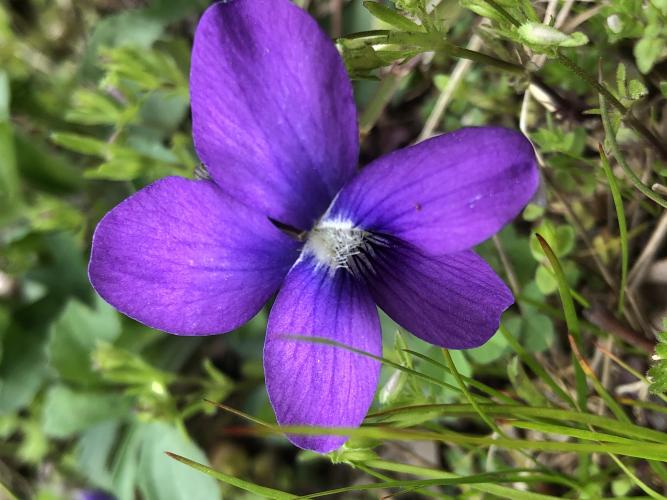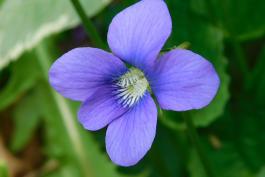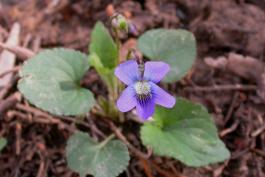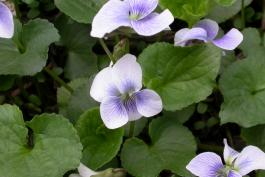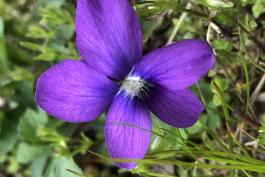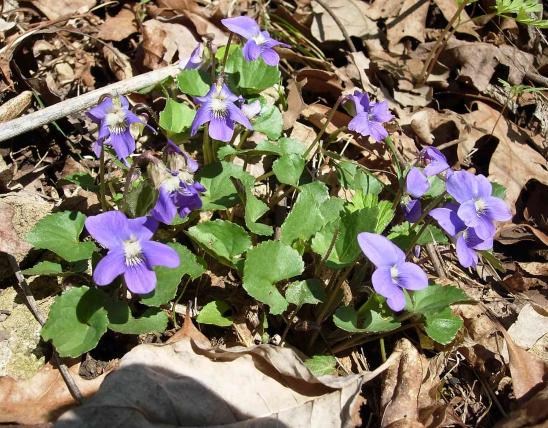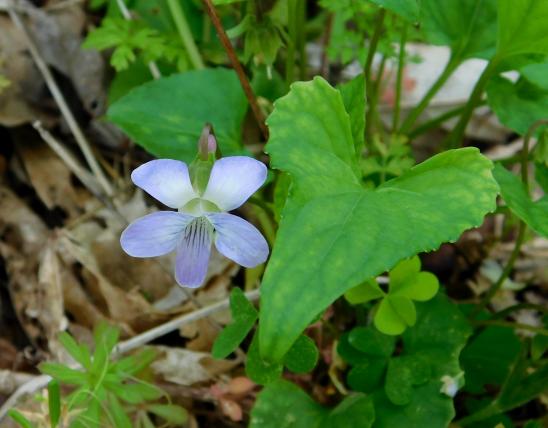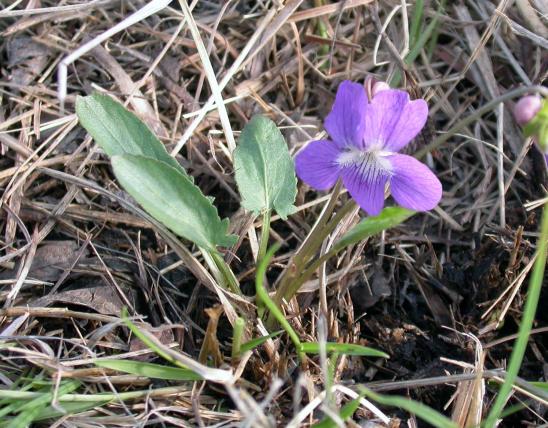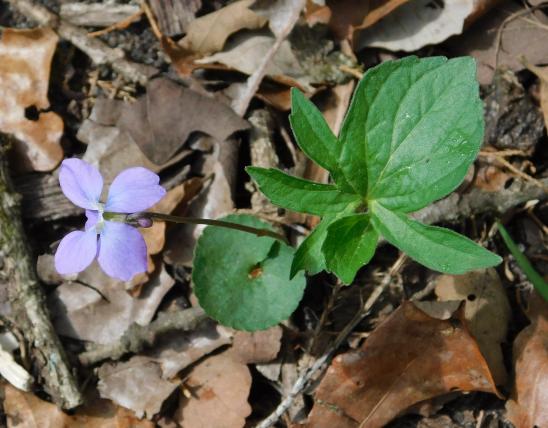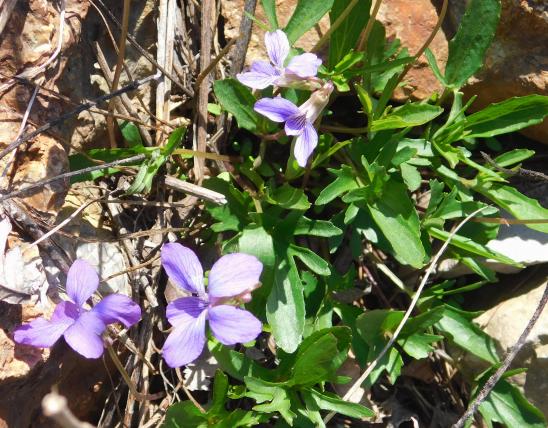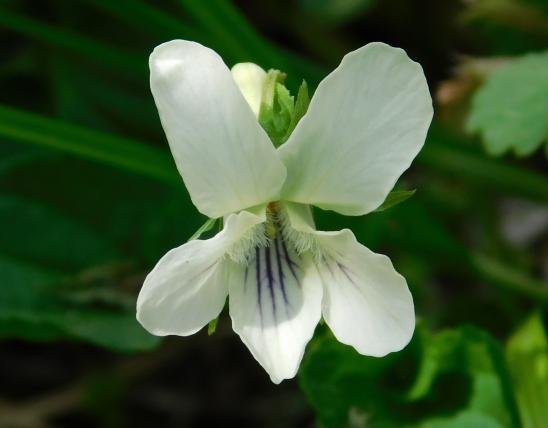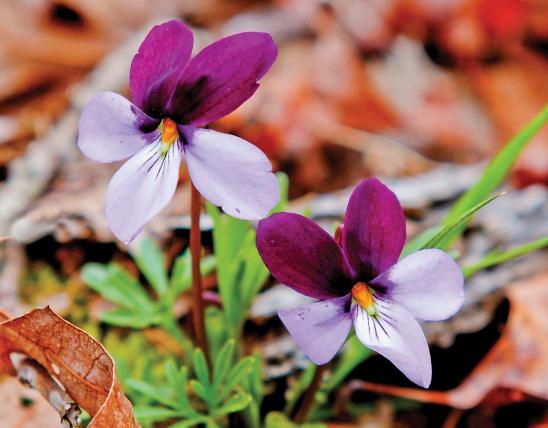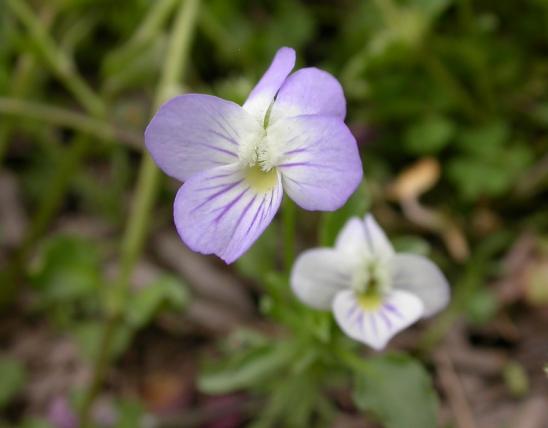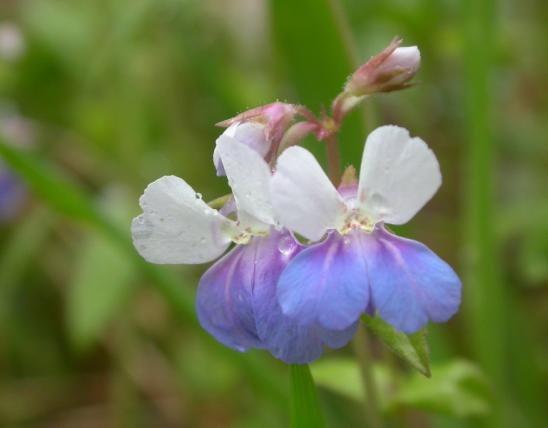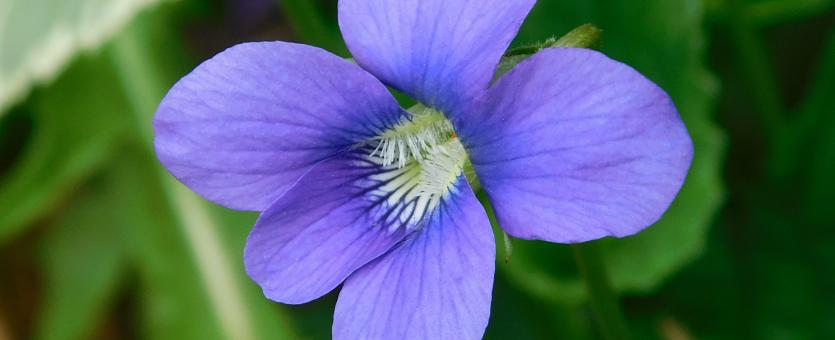
The common violet is one of 17 species of violets in Missouri, and true to its name, it is indeed common and widespread in our state. It is also quite variable, and botanists have debated how much variation this species comprises. In the past, some of the variants were thought to be separate species, so this species has a lot of scientific name synonyms. This, and the fact that this species sometimes hybridizes with close relatives, can make for some tricky identification. Fortunately, because the common violet is so common and widespread, chances are that a violet you see that fits its description is probably indeed a common violet.
The common violet is one of several species that usually have purple or bluish flowers; that have unlobed heart- or kidney-shaped leaves; and that lack a true stem (that is, each leaf and flower has its own separate leaf stem that arises individually from the tip of the rootstock; there is no aboveground stalk to which alternate leaves and flowers are attached).
Violet flowers have 5 petals: The lowest petal forms a spur containing nectar, and the 2 side petals typically have a tuft of hairs ("beard") on the upper (inner) side; in this species, the hairs are uniformly slender and not club-shaped at the tips. The lower petal in common violets is usually glabrous (hairless) or it may have a few slender hairs on the upper surface toward the base. The color of this species is variable: Some forms have violet flowers, which can vary in the intensity of the purple or blue; some have all-white flowers with purple veins on the lower petal. A third form, sometimes called the Confederate violet, has grayish-white petals with violet or blue veins and more solid patches of these colors on the inner portion of the petals, forming a broad, U-shaped eyespot. Blooms March–June, and sporadically into October–December.
Stems, leaves, or both with some degree of hairiness. Some forms are very hairy, some are nearly hairless. Leaves are heart-shaped or rounded, most being wider than long or about as wide as long; margins toothed/scalloped. The flowers are typically about as high as or only slightly overtopping the leaves.
Like many other violets, in addition to the showy flowers we tend to notice, the common violet also produces cleistogamous flowers, which tend to be positioned below the leaves and never open for cross-pollination. Instead, they remain closed and are self-pollinating, creating fertile seeds. In this species, the stalks of these cleistogamous flowers are prostrate or are abruptly arched.
The fruits are ovoid or nearly globe-shaped, about 3/8 inch long, green to dark green or olive green, usually mottled with purple, drying to tan or olive brown. The fruits eventually split open lengthwise into thirds to release the seeds, which are brown to dark brown, sometimes mottled with purple.
To learn more about Missouri's violets (genus Viola) as a group, visit their group page.
Similar species: In Missouri, there are 17 species in the genus Viola, plus a number of hybrids that can occur. The violets in our state that are most similar to V. sororia are the ones that are also stemless, blue/purple, with unlobed leaves. Below, they are listed roughly in order by how common or widespread they are in Missouri:
- Missouri violet (V. missouriensis) is scattered to common nearly statewide. Occurs mostly in moist or lowland habitats: bottomland forests, mesic upland forests, banks of streams and rivers, sloughs, margins of ponds, lakes, and sinkhole ponds, bottomland prairies, marshes; also ditches, fallow fields, lawns, railroads, roadsides, and disturbed areas. Very similar to V. sororia, and some authorities lump it in with that species. Leaf form and habitat help distinguish V. missouriensis: its leaf blades are longer than wide, unlobed, narrowly triangular to ovate-triangular, truncate (evenly perpendicular to the stem) to shallowly cordate (heart-shaped) at the base, the margins relatively untoothed on the outer third of the blade; otherwise coarsely toothed. Sometimes the flowers have a darker purple border to the whitish throat. Some have observed that the flowers of V. missouriensis are typically a lighter purple (lilac) than those of V. sororia.
- Blue prairie violet (V. nephrophylla, syn. V. pratincola) is uncommon and widely scattered, mostly south of the Missouri River. Lives on banks of streams and rivers, fens, margins of ponds, and other seepy areas; also in mine tailings, lawns, railroads, and roadsides. It is very similar to V. sororia, but it has thicker leaves that are finely, evenly toothed; the early season leaves are smaller and oval, often purplish on the undersides; also, its cleistogamous fruits are uniformly green, not purplish mottled, on erect, ascending stalks. This species is widely distributed in North America and is especially well-known in the western United States.
- Marsh violet (V. cucullata) is uncommon in the eastern half of the Ozarks and in nearby parts of the Ozark border. Lives in fens, acid seeps, and bases of bluffs. In this species, the flowers strongly overtop (rise above) the leaves. The flowers usually have a dark purple border next to the whitish floral throat, resembling an eyespot. The sepals are often noticeably 3-veined and uniformly tapering to very sharply pointed tips. The leaf blades are longer than wide and are ovate to heart-shaped, heart-shaped at the base, the margins finely toothed their entire length or they may be distinctly wider than to about as wide as long.
- Sand violet (V. affinis) is uncommon, a Missouri species of conservation concern, ranked as critically imperiled; it was first documented in our state in 2009 in New Madrid County. Lives in swamps, bottomland forests, and shaded levees. It is similar to V. cucullata but is distinguished by having its open flowers about the same height as the leaves. Also, although its long-tapered leaf tips are similar to those of V. missouriensis, it can be distinguished from that species by its leaf blades being more deeply cordate at the base and more finely and regularly toothed along the margins.
Be aware that three other stemless Missouri violets also produce blue or purplish flowers and, in early spring and late summer, have leaves that are unlobed and heart- or kidney-shaped; however, in these species, the mature plants, from mid-spring until late summer, produce leaves that are lobed: cleft or three-lobed violet (V. palmata), arrow-leaved, arrowhead, or arrowleaf violet (V. sagittata), and plains violet (V. viarum).
Plant height: usually 6–12 inches.
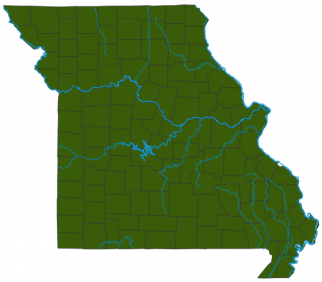
Statewide.
Habitat and Conservation
Occurs in bottomland forests, rich (mesic) to dry upland forests, banks of streams, rivers, and spring branches, margins of ponds, lakes, oxbows, and sinkhole ponds, bases, ledges, and tops of bluffs, upland prairies, glades, and savannas; also in ditches, fallow fields, orchards, pastures, lawns, gardens, cemeteries, railroads, roadsides, and disturbed areas. It is often cultivated.
Status
Native Missouri wildflower. Used in native wildflower gardening. Leaves and flowers are edible. Because it spreads easily in cultivation, some consider it a weed.
At least in part, the many common names of this species reflect what botanists call its "most tortuous nomenclatural history." Among the many older scientific names that apply to this species are V. domestica and V. septentrionalis. Glabrous (hairless) forms were once considered V. papilionacea, the butterfly violet. Be aware that different references will group, split, and name the species and varieties differently.
Also, the different color variants have been given official names; for example, the white-flowered strain has been labeled forma alba, and the variant that is white with purple spots, called Confederate violet, has been called f. priceana. What is today considered the separate species Missouri violet (V. missouriensis) used to be considered a variety of common violet (V. sororia var. missouriensis).
Human Connections
Violets have many uses as wild edibles. The flowers can be dipped in stiff egg whites, rolled in sugar, and allowed to dry, to make a striking, decorative confection. The flowers can also be made into jelly, and the leaves and flowers used in green salads.
The genus name, Viola, is the ancient Roman name for flowers in this genus. The species name, sororia, is Latin for "sister" and refers to its resemblance to several other species in the genus.
Ecosystem Connections
White-tailed deer and other animals nibble the leaves. Bees glean nectar from the flowers. Violets are the caterpillar food plants for fritillary butterflies, including the great spangled fritillary, Diana fritillary, and regal fritillary.
